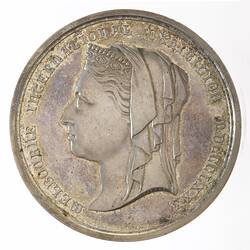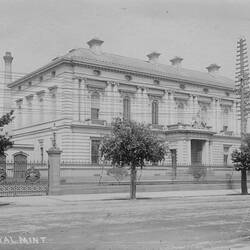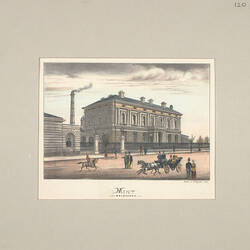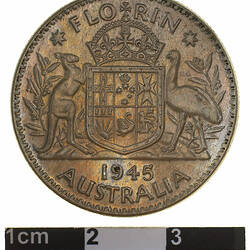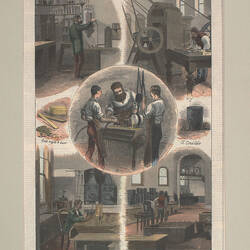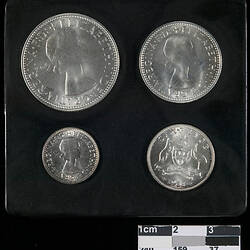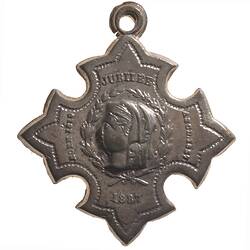Summary
Australia Victoria Melbourne
Medal - Melbourne International Exhibition, Silver 1880 (AD)
Mint: Melbourne
Awarded to: Noone, John
Other Details: This Melbourne International Exhibition medal is one of many medals awarded to Melbourne photographer and lithographer John Noone in the 1870s and 1880s. He was Chairman of Jury Section V at the Exhibition, assessing 'Photographic Proofs and Apparatus' (Official Record, p.43) and won this particular medal himself for his 'Post-lithographic and Photo-Zincographic Reproductions of Manuscript, Lithographed or Engraved Maps' (Jury Section 1 - Fine Arts - Official Record, p.427). The jurors were annoyed with the presentation of some of this category, complaining that 'the British collection was so poorly placed, being hung upon one of the staircases, wherre proper inspection is almost impossible' (op.cit., p.22). Most of Noone's medals were won in Australian exhibitions, but he was also successful in London and at the Bengal Photographic Society exhibition of 1874. The Melbourne International Exhibition ran from 1 October 1880 to 30 April 1881. The exhibition building that still stands was constructed for the occasion, designed by Joseph Reed and built by David Mitchell. Over 1.3 million people visited the exhibition at a time when Melbourne's population was only around 282,000.
Physical Description
A silver prize medal (51 mm diameter) awarded to J. Noone for his entry of engraved maps. It features a veiled head of Queen Victoria.
Obverse Description
At centre, head of Queen Victoria left, veiled and diademed; around, MELBOURNE INTERNATIONAL EXHIBITION MDCCCLXXX :
Reverse Description
Within wreath, "VITAM / EXCOLVERE / PER ARTES"
Edge Description
J. NOONE, MELBOURNE _ ENGRAVED MAPS
Significance
A competition for the design of a prize-winners medal for the 1880 Melbourne International Exhibition was arranged by the Exhibition Commission. A Committee was formed and a sketch produced to guide entrants to the competition. The competition was to be judged by V. Delves Broughton, Deputy Master of the Melbourne Mint, who would later oversee the actual production.
Broughton was not involved in the Committee's discussion about the preferred design, and was horrified when he saw the guide sketch that had been sent out to interested artists. The design was too complex (and, according to Broughton's correspondence, the relief too deep) to be produced. It appears he hastily wrote to each artist indicating that variations on the design were welcomed, and that the choce of winner would be based on which could be made from the thinnest guage of metal. He advised that the head of the Queen was unsuited to the task, and suggested that the Queen's head on the obverse of the Ashantee war medal by L.C. Wyon, featured in the Exhibition Catalogue, was a good model. Entrants were also directed to look at ancient medals and coins exhibited by the Mint.
The competition was won by Melbourne medallist and jeweller Ernst Altmann. The Melbourne Mint still rejected the design as too difficult to strike. Eventually a modified form of the Ashantee medal from the Sydney Mint presentation medal was used, combined with a simple reverse with wreath design entered by medallist Harry Stokes.
The medals were minted, and awarded in the folliwng manner. Gold, first prize with medal, for applications of new and useful principles, the production of useful machines, or great skill in manufacture, invention or design. Gold, second prize with certificate, for objects of art. Gold, third prize with certificate, for manufactures, products and industries of high merit. Silver and bronze medals were awarded for exhibits of lesser importance; silver and bronze level certificates were issued to lesser winners in each of these categories. -Sharples, John P. 1990. Medals as Art: Australia and the Meszaros tradition, p.16. - D. Tout-Smith 23/10/2003.
More Information
-
Collecting Areas
-
Acquisition Information
Purchase from Spink Noble Numismatics, 13 Nov 1992
-
Date Issued
1880 AD
-
Issued By
-
Mint
-
Artist
-
Awarded To
John Noone, Melbourne, Greater Melbourne, Victoria, Australia, 1880
-
Person Depicted
-
Inscriptions
Edge impressed: J. NOONE, MELBOURNE _ ENGRAVED MAPS Obverse: MELBOURNE INTERNATIONAL EXHIBITION MDCCCLXXX Reverse: "VITAM / EXCOLVERE / PER ARTES" below in tiny letters, H.STOKES
-
Series
-
Material
Silver
-
Axis
12
-
Classification
-
Category
-
Discipline
-
Type of item
-
Dimensions
51 mm (Outside Diameter), 91.86 g (Weight)
-
Shape
Round
-
References
[Book] 1882. Official Record of the Melbourne International Exhibition 1880-1881.
[Article] Pryde, Pam. 2006. John Noone, Government Photo-lithographer, 1861-1888. Script & Print: Bulletin of the Bibliographical Society of Australia and New Zealand. 30 (1): 31-38.
-
Keywords

